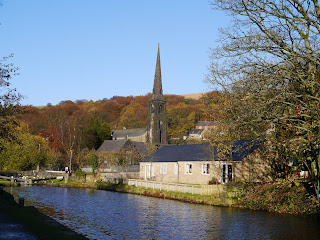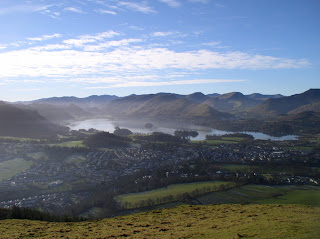On the 5th May earlier this year I got to the top of Great Calva and in doing so completed all the fells covered in 'The Northern Fells', Book Five in Wainwright's series of pictorial guides to the Lakeland Fells.
It had taken me 11 walks to do all of the 24 fells and I thoroughly enjoyed each one of them. Indeed I have a real soft spot for the Northern Fells. It is obvious though that not everyone holds them in such high esteem. For instance, I remember meeting a couple of other walkers on Brae Fell and when I said how lovely the area was they were fairly dismissive. Even Wainwright, who at one point in his conclusion to Book Five realises he is in danger of becoming too enthusiastic, backtracks somewhat and adds that compared to the fells surrounding Borrowdale, Langdale and Wasdale the Northern Fells are, "not in the same class."
Of course what constitutes good fell-walking country is highly subjective but I'd guess that most people would concur with Wainwright and that the Northern Fells wouldn't rate too highly in many people's favourite Lakeland areas. In an attempt therefore to change perceptions of the Northern Fells here are, in no particular order, my '10 reasons to love the Northern Fells':
1. Sharp Edge - Wainwright lists no less than 12 routes to the top of Blencathra. I've so far only done two of them, the first time up the Hall's Fell ridge and then the second time via Sharp Edge, perhaps the finest ridge in the Lake District. Striding Edge is more famous but Sharp Edge is better. For a start you'll meet a lot fewer people and there is a reason for that - it is a lot scarier!
2. Mungrisdale Common - The very antithesis of Sharp Edge, the broad, featureless expanse of Mungrisdale Common is, by any reasonable way of measuring these things, not even really a separate fell at all. It is actually, like Sharp Edge, a part of Blencathra. It is tempting to think that Wainwright included it in his 'Northern Fells' as something of a joke. Yet by including it far more people have crossed its 'summit' than would ever have done otherwise. My visit to Mungrisdale Common came on the same walk as Sharp Edge. It was on Mungrisdale Common that I sat and ate my lunch with no one else about whilst listening to the song of the local skylarks. In truth I enjoyed these moments of pure relaxation as much as the adrenaline rush of Sharp Edge. Where else in the Lakes can you get such a contrast?
3. I wandered lonely as a cloud - While the opening line of Wordsworth's most famous poem were inspired by a walk in the woods on the lakeshore of Ullswater they could refer to the Northern Fells. Wainwright claimed that apart from on Skiddaw and Blencathra he didn't pass any other walkers in two years of tramping the Northern Fells. While that is highly unlikely to happen nowadays (ironically, thanks in part to Wainwright) these fells are still remarkably quiet compared to most areas of the Lake District. For hill walkers who like to get away from the crowds the Northern Fells hold an appeal far greater than the fells of Borrowdale, Langdale and Wasdale. The only Wainwright I've visited three times is Knott and, apart from my wife who was with me the first time, I didn't see a single other person each time.
4. Skiddaw
- Recently, whilst staying in the Eskdale Youth Hostel, I got talking with a couple of other walkers who expressed some surprise when I said that Skiddaw was one of my favourite fells. It seems that despite being the 4th highest mountain in England (as well as being much older than most of the Lakeland Fells) there have always been doubters as to the worth of Skiddaw, hence Wainwright's eloquent defence of the fell. As Wainwright notes Skiddaw is one of the noblest looking fells in the Lakes. I don't think I could ever tire of the view of Skiddaw from Keswick and Derwent Water. It is the true overlord of the surrounding fells, something that cannot be said for Helvellyn for instance.While the main path from Keswick may not be the most exciting climb in the world the approach via Ullock Pike, Long Side and Carl Side is magnificent and gives you a real appreciation for the sheer size of Skiddaw. My first visit to Skiddaw was via the Ullock Pike ridge with the descent made via Bakestall and the Dash valley and it remains one of my favourite walks. The views from the top are pretty awesome too.

5. Great Cockup
- Up there with Bodmin Moor's Brown Willy and Lord Hereford's Knob in the Black Mountains for having one of the more amusing fell names Great Cockup is certainly a more original name than the endless number of Dodds that can be found in certain parts of the Lakes. However, there is more to Great Cockup than its chucklesome name. On a clear day the view north beyond Binsey, an outlier of the Northern Fells, and across the Solway Firth to Criffel and beyond is magnificent.
6. Latrigg
- Is there another fell in the Lakes where it is possible to get such a good view for so little effort? Latrigg is an easy walk from Keswick and the reward is a superb view south across Derwent Water. If the walk is extended by a descent along the east ridge to Brundholme and then a return to Kewsick via the old railway line then a lovely walk will have been had.
7. Trusmadoor
- A small, narrow pass separating Great Cockup from Meal Fell, Trusmadoor is an atmospheric little gem.
8. Lonscale Fell's north-east buttress
- It might surprise people when I say the most nerve wracking ascent I've made in the Lake District was up Lonscale Fell. As the fell is for the most part grassy and fairly featureless I decided to add interest by taking the route Wainwright describes up the north-east buttress direct to the east peak. While Wainwright describes the route as 'for scramblers only' he also says, 'there is little need to handle rock'. As the route became increasingly steep towards the top and the view back down increasingly precipitous I began to wish for a bit more rock for something to hold on to. I'll happily admit that when I got to the top my legs were a bit wobbly. At the time I vowed never to do it again, over a year later I quite fancy another crack at it.
9. Uldale Fells - To the north of Knott is a small group of hills called the Uldale Fells, including the likes of Great Sca Fell (about as different from the famous Sca Fell as it is possible to get), Meal Fell, Brae Fell, Longlands Fell and Lowthwaite Fell. The Uldale Fells are smooth grassy hills with steep flanks. They are a delight to walk on and I can think of no better compliment than to describe them as like a miniature version of the Howgill Fells. Like the Howgill Fells there are very few walls of fences in the Uldale Fells and this, combined with the nature of the terrain, means that walkers have a wonderful freedom to explore wherever they want. Another thing the Uldale Fells have in common with the Howgills is the presence of wild ponies. The first time I happened across these magnificent animals in the Northern Fells a small herd trotted right past us on the path leading to Trusmadoor. It was a thrilling moment and not one you are likely to experience in many other areas of the Lake District.

10. Carrock Fell - At the end of Book Seven, 'The Western Fells', Wainwright, somewhat reluctantly lists his favourite fells. Before doing so he mentions several other fells that were high on the list but didn't quite make it, mainly due to lack of height. Carrock Fell is one of those that didn't quite make it. Compared to most of the Northern Fells it is quite a rough hill with rock and heather in abundance. The climb up from Mosedale is enjoyably intricate, there being a distinct lack of a well trodden path. The best thing about Carrock Fell though is its rocky summit which is adorned with the remains of an ancient hill fort and which provides a super view across the Eden valley towards the North Pennines.
Those then are my '10 reasons to love the Northern Fells'. Apologies to the east ridge of Bannerdale Crags which deserves a more than honourable mention as does the summit of High Pike with its cairn, trig point and handy memorial bench. I've not yet ventured into Roughten Gill but suspect that that too would prove to be another reason to love the Northern Fells.


























